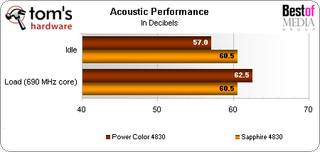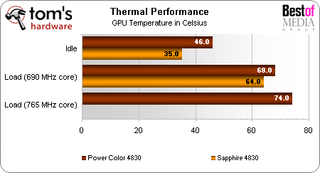Radeon HD 4830: High-Speed, Cheap CrossFire
Functional Benchmarking: Noise And Heat
Nobody wants a video card that sounds like a vacuum cleaner under load, so we measured how these cards performed acoustically. To our surprise, they were a little too quiet to measure in the usual way by reading the noise at the back of the case. So to get meaningful readings, we had to open the case and measure the noise within an inch of each card. This tells us that both PowerColor and Sapphire have reasonably quiet cooling solutions on their 4830s. Here are the results:

As you can see in our benchmark, PowerColor’s card seemed to make use of variable fan speeds while Sapphire’s card tended to use only a single-fan speed in testing. While the chart shows some variance, the real-world difference was negligible as neither card was really audible over our Cooler Master Cosmos-S case in regular conditions.
Our final benchmark is heat. We know the cooling systems are quiet, but let’s see how effective they are:

At first glance, the Sapphire card looks like a superior solution at idle. But keep in mind that the Sapphire 4830 idled at only 160 MHz on the core and 250 MHz on the memory, while PowerColor’s idled at 453 MHz on the core and 750 MHz on the memory. This accounts for the large variance in idle-speed temperatures.
Once the cards are put under a load, we can see a more reasonable temperature difference. Overclocked to 690 MHz, the temperature of both the PowerColor and Sapphire 4830 cards hovered from a mid to high 60 degrees Celsius, with the Sapphire card showing a slight advantage. This isn’t that significant when you realize that we don’t need to worry about these graphics processors until their temperatures reach at least 90 degrees Celsius.
Even overclocked to 765 MHz on the core, the PowerColor 4830 still kept the temperature under 80 degrees Celsius. This is an excellent load temperature for such a high overclock, showing that the RV770LE graphics processor really is designed to handle a much higher clock speed than the stock 575 MHz.
Stay on the Cutting Edge
Join the experts who read Tom's Hardware for the inside track on enthusiast PC tech news — and have for over 25 years. We'll send breaking news and in-depth reviews of CPUs, GPUs, AI, maker hardware and more straight to your inbox.
-
Doltron If you couldn't get Tray Tools to work with the Sapphire card why not use another program? Instead of giving up and coming up with a lame conclusion.Reply
Also 993*2 doesn't equal 1885 and the 4870 is clocked at 750 not 780.
Your sound and temp charts have FPS on their X axis. -
hannibal It's nice to see good cards from both companies, ATI and NVidia!Reply
And the price is not bad at all. The competition is so good!
-
neiroatopelcc The chart on page two sais 4850 runs at 625 - but stock is 600, and 4870 at 780 - which is 750 stock ... so is the 4830 speed correct?Reply -
V3NOM I'm sure i saw that "4850 - smarter by design" article at anandtech first. or somewhere else... the name anyway not necessarily the article >.>Reply -
giovanni86 I knew that the 8800GT wasn't that fast, but those benchmarks ahve to be wrong... Sorry Nvidia fan boy here. Bye.Reply -
V3NOM Um actually, the MSI runs at x16/x8 in SLI mode. If you instead got an evga 750i FTW motherboard, you would find it runs at x16/x16 in sli, thanks to its unlocked NF200 chip. the 750i FTW is not a reference nvidia board as the MSI is.Reply
Most Popular

